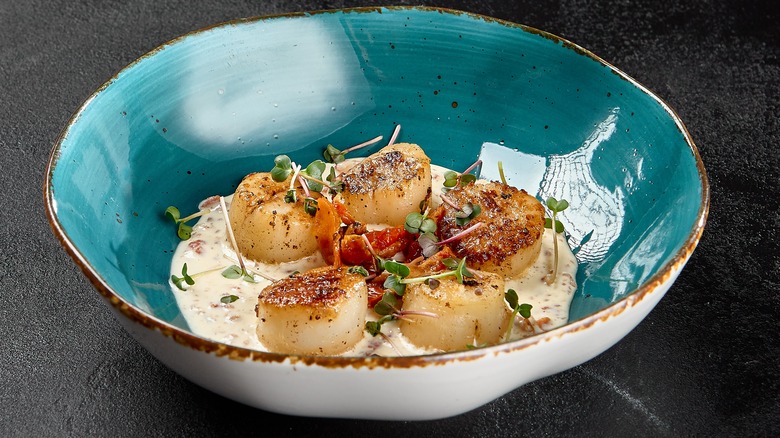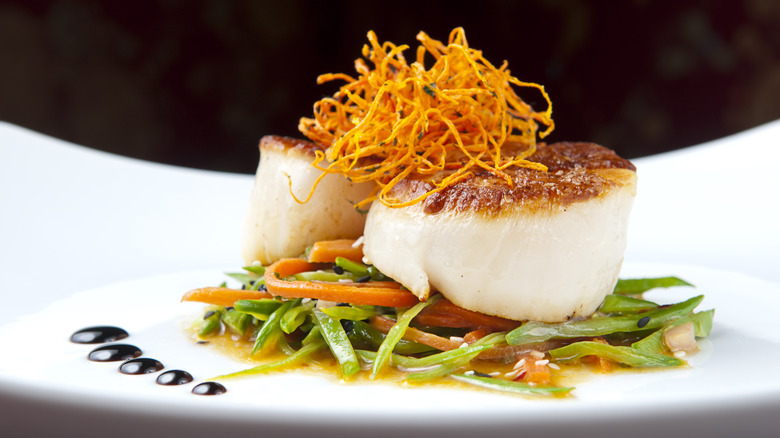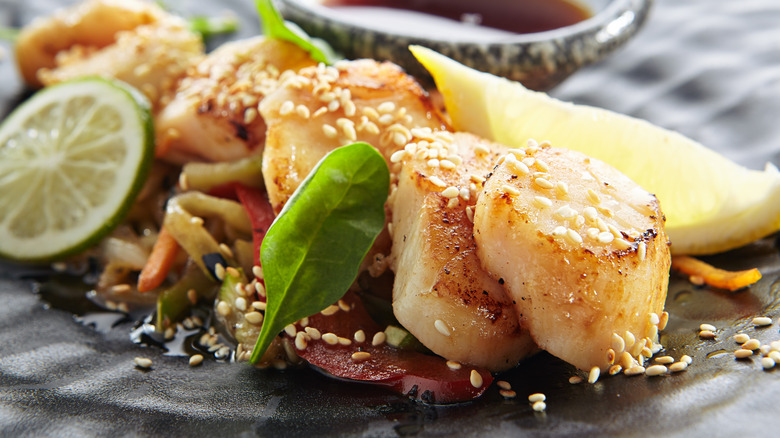Wet And Dry-Packed Scallops Are Not As Similar As You'd Think
Buying the perfect scallops can make the difference between a deliciously seared dinner and a tough, bitter mess. A quality batch will ensure your ability to dry these mollusks sufficiently so that they crisp up nicely in a cast-iron skillet, giving you that elusive, restaurant-quality browning that will impress any dinner table. This makes shopping a crucial first step in the cooking process. Whether you're visiting your local fish market or the seafood section of your grocery store, you'll want to steer clear of wet-packed scallops for a myriad of reasons.
Wet-packed scallops get their name from the saline solution they are infused with during manufacturing. While this solution gives them a longer expiration date, the briny liquid imparts a soapy overtone to these mollusks that can be difficult to mask or ignore in any dish. This extra liquid will also account for part of the weight of the product you purchase, making these scallops pricier than their actual volume warrants.
Dry-packed scallops will give you a nicer sear
Water should be considered the biggest enemy of searing, as a moist exterior can easily hinder the browning process and wash off many of the surface sugars and protein compounds that would otherwise fry up. Wet-packed scallops are not immune to this issue either. Because of the added internal brine, these mollusks release much more water under high heat, which makes achieving that golden exterior more challenging than it should be. As they cook, wet-packed scallops will also shrink considerably, since much of their size is due to that liquid. This will leave you with tiny, unappetizing morsels that are less than ideal for a substantial meal.
Dry-packed scallops are ultimately superior, as they are not injected with any preservatives that will affect their size, taste, and texture. While they tend to run smaller and don't last as long as their wet counterparts, these untreated mollusks caramelize much easier in a pan, as long as you remember to wick their surface of any extra moisture. They also don't impart any detergent-like undertones into your food, so you're left with delicious, meltingly tender scallops.
Soak your wet scallops in water to remove excess brine
If you can't find any dry-packed scallops at your grocer, or if you happen to have some of the wet variety on hand, don't worry. While it may seem counterintuitive, you can submerge your wet-packed mollusks in cold water seasoned with a little salt and lemon juice. Given enough time, this liquid will draw out the brine from the inside of the scallop, leaving you with a far more neutral base you can season yourself.
While this hack addresses the flavor issue, keep in mind that you'll still have to contend with the caramelization challenges of wet-packed scallops due to the added moisture. You can attempt to combat this by tossing your scallops in flour, but be aware that the benefits of this method are often minimal at best, and can still be easily hindered by water. Alternatively, you can choose to sear only one side of the scallop, as the longer cooking time on one surface will give you a better chance of achieving a browned finish on at least part of the mollusk. However, to be honest, you're always better off taking the time and effort to get dry-packed scallops.



